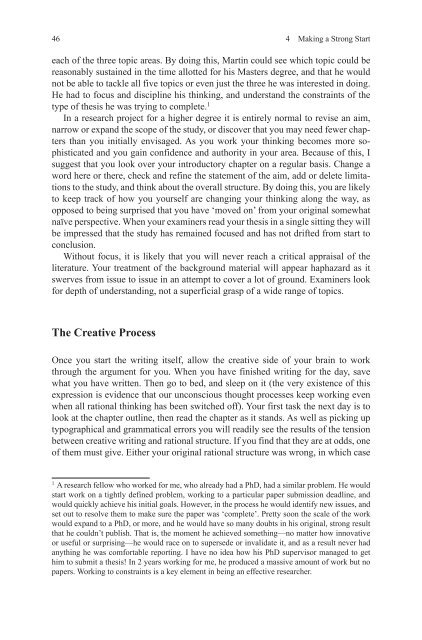How-to-Write-a-Better-Thesis
Create successful ePaper yourself
Turn your PDF publications into a flip-book with our unique Google optimized e-Paper software.
46 4 Making a Strong Start<br />
each of the three <strong>to</strong>pic areas. By doing this, Martin could see which <strong>to</strong>pic could be<br />
reasonably sustained in the time allotted for his Masters degree, and that he would<br />
not be able <strong>to</strong> tackle all five <strong>to</strong>pics or even just the three he was interested in doing.<br />
He had <strong>to</strong> focus and discipline his thinking, and understand the constraints of the<br />
type of thesis he was trying <strong>to</strong> complete. 1<br />
In a research project for a higher degree it is entirely normal <strong>to</strong> revise an aim,<br />
narrow or expand the scope of the study, or discover that you may need fewer chapters<br />
than you initially envisaged. As you work your thinking becomes more sophisticated<br />
and you gain confidence and authority in your area. Because of this, I<br />
suggest that you look over your introduc<strong>to</strong>ry chapter on a regular basis. Change a<br />
word here or there, check and refine the statement of the aim, add or delete limitations<br />
<strong>to</strong> the study, and think about the overall structure. By doing this, you are likely<br />
<strong>to</strong> keep track of how you yourself are changing your thinking along the way, as<br />
opposed <strong>to</strong> being surprised that you have ‘moved on’ from your original somewhat<br />
naïve perspective. When your examiners read your thesis in a single sitting they will<br />
be impressed that the study has remained focused and has not drifted from start <strong>to</strong><br />
conclusion.<br />
Without focus, it is likely that you will never reach a critical appraisal of the<br />
literature. Your treatment of the background material will appear haphazard as it<br />
swerves from issue <strong>to</strong> issue in an attempt <strong>to</strong> cover a lot of ground. Examiners look<br />
for depth of understanding, not a superficial grasp of a wide range of <strong>to</strong>pics.<br />
The Creative Process<br />
Once you start the writing itself, allow the creative side of your brain <strong>to</strong> work<br />
through the argument for you. When you have finished writing for the day, save<br />
what you have written. Then go <strong>to</strong> bed, and sleep on it (the very existence of this<br />
expression is evidence that our unconscious thought processes keep working even<br />
when all rational thinking has been switched off). Your first task the next day is <strong>to</strong><br />
look at the chapter outline, then read the chapter as it stands. As well as picking up<br />
typographical and grammatical errors you will readily see the results of the tension<br />
between creative writing and rational structure. If you find that they are at odds, one<br />
of them must give. Either your original rational structure was wrong, in which case<br />
1<br />
A research fellow who worked for me, who already had a PhD, had a similar problem. He would<br />
start work on a tightly defined problem, working <strong>to</strong> a particular paper submission deadline, and<br />
would quickly achieve his initial goals. <strong>How</strong>ever, in the process he would identify new issues, and<br />
set out <strong>to</strong> resolve them <strong>to</strong> make sure the paper was ‘complete’. Pretty soon the scale of the work<br />
would expand <strong>to</strong> a PhD, or more, and he would have so many doubts in his original, strong result<br />
that he couldn’t publish. That is, the moment he achieved something—no matter how innovative<br />
or useful or surprising—he would race on <strong>to</strong> supersede or invalidate it, and as a result never had<br />
anything he was comfortable reporting. I have no idea how his PhD supervisor managed <strong>to</strong> get<br />
him <strong>to</strong> submit a thesis! In 2 years working for me, he produced a massive amount of work but no<br />
papers. Working <strong>to</strong> constraints is a key element in being an effective researcher.














![[Lonely Planet] Sri Lanka](https://img.yumpu.com/59845622/1/169x260/lonely-planet-sri-lanka.jpg?quality=85)


